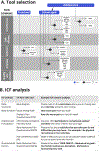Cerebral palsy pain instruments: Recommended tools for clinical research studies by the National Institute of Neurological Disorders and Stroke Cerebral Palsy Common Data Elements project
- PMID: 37650571
- PMCID: PMC10902183
- DOI: 10.1111/dmcn.15743
Cerebral palsy pain instruments: Recommended tools for clinical research studies by the National Institute of Neurological Disorders and Stroke Cerebral Palsy Common Data Elements project
Abstract
Aim: This study describes the process of updating the cerebral palsy (CP) common data elements (CDEs), specifically identifying tools that capture the impact of chronic pain on children's functioning.
Method: Through a partnership between the American Academy for Cerebral Palsy and Developmental Medicine and the National Institute of Neurological Disorders and Stroke (NINDS), the CP CDEs were developed as data standards for clinical research in neuroscience. Chronic pain was underrepresented in the NINDS CP CDEs version 1.0. A multi-step methodology was applied by an interdisciplinary professional team. Following an adapted CP chronic pain tools' rating system, and a review of psychometric properties, clinical utility, and compliance with inclusion/exclusion criteria, a set of recommended pain tools was posted online for external public comment in May 2022.
Results: Fifteen chronic pain tools met inclusion criteria, representing constructs across all components of the International Classification of Functioning, Disability and Health.
Interpretation: This paper describes the first condition-specific pain CDEs for a pediatric population. The proposed set of chronic pain tools complement and enhance the applicability of the existing pediatric CP CDEs. The novel CP CDE pain tools harmonize the assessment of chronic pain, addressing not only intensity of chronic pain, but also the functional impact of experiencing it in everyday activities.
© 2023 The Authors. Developmental Medicine & Child Neurology published by John Wiley & Sons Ltd on behalf of Mac Keith Press.
Conflict of interest statement
CONFLICT OF INTEREST
The authors have stated that they had no interests that might be perceived as posing a conflict or bias.
Figures

References
-
- Schiariti V, Fowler E, Brandenburg JE, Levey E, McIntyre S, Sukal-Moulton T, et al. A common data language for clinical research studies: the National Institute of Neurological Disorders and Stroke and American Academy for Cerebral Palsy and Developmental Medicine Cerebral Palsy Common Data Elements Version 1.0 recommendations. Dev Med Child Neurol. 2018; 60: 976–86. - PubMed
-
- National Library of Medicine. Common Data Elements (CDEs) Bethesda, MD: National Institutes of Health; 2022. Available from: https://www.nlm.nih.gov/oet/ed/cde/tutorial/03-100.html#:~:text=A%20comm....
-
- Schiariti V. Standardized and individualized care: do they complement or oppose each other? Dev Med Child Neurol. 2018; 60: 1059. - PubMed
Publication types
MeSH terms
Grants and funding
LinkOut - more resources
Full Text Sources
Medical
Miscellaneous

